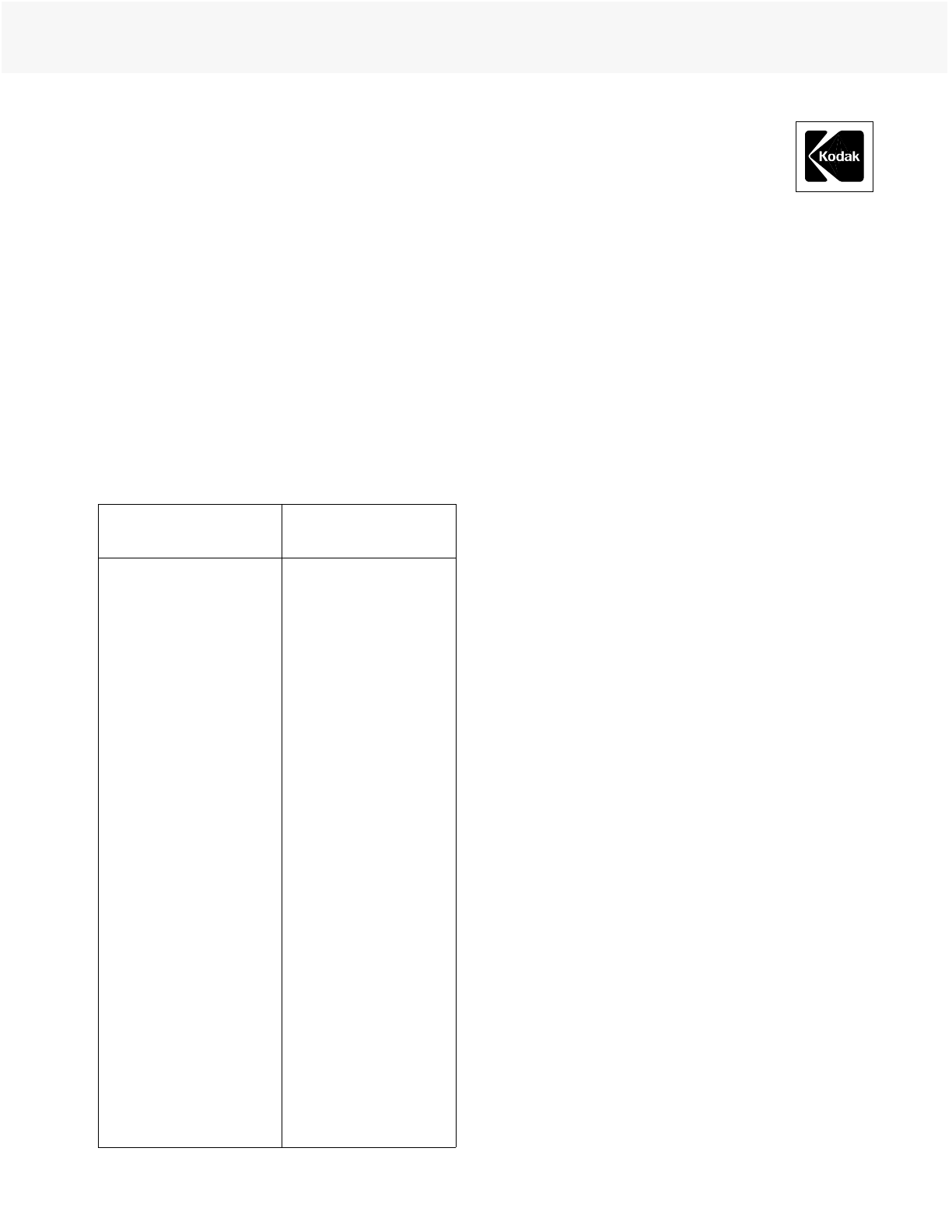
©Eastman Kodak Company, 1998
September 1998 • H-1-2393t
TECHNICAL DATA /
COLOR PRINT FILM
KODAK VISION Premier
Color Print Film / 2393
™
RICHER COLORS ON THE SCREEN
Now, there’s a new choice in motion picture print films—
KODAK VISION Premier Color Print Film. A film with a
different look. Richer blacks. More saturated colors.
Cleaner performance. A film worthy of the KODAK
VISION Film family name.
The upper tone scale of VISION Premier Film is
significantly higher in density than EASTMAN EXR
Color Print Film, so shadows are deeper, colors are more
vivid, and the image snaps and sizzles on the screen. The
toe areas of the sensitometric curves are matched more
closely, producing more neutral highlights on projection.
Cinematographers can be more creative with lighting and
exposure, and still see remarkable results.
BENEFITS FOR LABS
BENEFITS FOR
DISTRIBUTORS/
EXHIBITORS
• Polyester base provides
greater tear strength,
durability, dimensional
stability, and archival
keeping
• Elimination of rem-jet (no
carbon black or prebath-
soluble binder)
• Potential for reduced
chemical and water usage
in processing
• Improved cleanliness on
high-speed printers (less
white dirt)
• Protection fromstaticmarks
prior to printing
• Reduced dirt attraction to
processed prints and static
protection prior to
processing
• Better transport
characteristics for
processed film
• Superior halationprotection
(no colored fringes in titles)
• Improved safelight edgefog
protection for digital
soundtrack area
• Improved fades and
dissolves, and less
propensity to safelight fog
• Extremely rich blacks,
higher color saturation, and
more neutral highlights on
projection
• Improved laser subtitling
• Polyester base allows
cleaner, more durable
prints
• No colored fringes in
titles, and improved
safelight edgefog
protection for digital
soundtrack
• Improved fades and
dissolves, and less
propensity to safelight fog
• Extremely rich blacks,
higher color saturation,
and more neutral
highlights on projection
• Improved laser subtitling
Like itscounterpart KODAKVISION ColorPrint Film,
VISION Premier Film is coated on a polyester base
without rem-jet, for a cleaner process and cleaner screen
images. We’ve incorporated a processing-surviving,
anti-static layer to reduce dirt attraction, and a
scratch-resistant backing layer to improve projection life.
And there are no color shifts during fades and dissolves.
So, from set to lab to screen, day to day, you’ll have more
consistent performance.
These are not incremental improvements. They are
quantum leaps forward in film technology. And with
VISION Premier Film, you’ll have the finest motion
picture color print film Kodak has ever made.
STORAGE
Unexposed print film is not adversely affected by
short-term storage at room temperature (less than 25˚C
(77˚F). Storeunexposedfilm at 13˚C(55˚F) orlowerwhen
storage exceeds 1 month. If refrigerated, allow the sealed
can or foil bag to equilibrate to room temperature before
opening to avoid condensation. Rebag unused raw stock
and seal it in film cans before returning it to refrigeration.
Process exposed film promptly. This film exhibits
excellent latent image keeping. When exposed film must
be kept several days before processing, the tone scale of
VISION Premier Color Print Film / 2393 shows little
change. Depending on the storage temperature, labs can
compensate for the small latent image speed loss by
increasing printer TRIMS slightly (a neutral increase of 1
to 2printer points) if thereis a longdelay between printing
and processing. You can slow changes in latent image by
storing exposed film at lower temperatures. For critical
applications, such as sensitometric exposures used for
process control, keep exposed film strips at 0˚C (32˚F) or
lower.
For short-term “active” storage and projection of
processed prints (e.g., commercial film exchanges and
theatres), store at room temperature of 20 to 25˚C (68 to
77˚F) at 50 to 60 percent relative humidity. Avoid
prolonged unconditioned storage at high temperatures or
excessive humidity. For medium-term storage, store at
10˚C (50˚F) or lower, at a relative humidity of 20 to 30
percent. For more information on long-term storage, see
KODAK Publication No. H-23, The Book of Film Care.
For extended-term storage (for preservation of material
having permanent value), store at 2˚C (36˚F) or lower,at a
relative humidityof 20 to30 percent. MolecularSieves
*
in
a sealed can will provide additional benefit.
